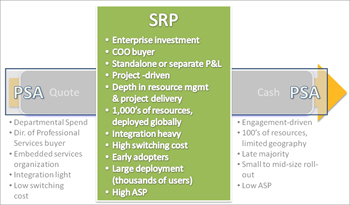
As a follow up to a recent Webcast I participated in titled, The Missing Perspective: A Resource View for Service Driven Organizations, I wanted to begin a dialog around the key take-a-ways addressed in the Webcast as it provides a new perspective and insight into who is using Services Resource Planning (SRP) and why. I have an interest and passion for this topic based on my experience and seeing our customer success. Presented in a three part blog series, I will cover the differences between SRP and Professional Services Automation (PSA), the pain service businesses are facing in today’s global economic climate and finally the requirements, key drivers, and recommendations for optimizing your service driven business. To begin the conversation this post will address the differences between SRP versus PSA.
SRP versus PSA
Contrary to traditional thinking, SRP and PSA solutions serve different markets and bring contrasting functionality and value to the table. PSA provides a high level view of what needs to be done in the business and works for everyday mechanics but it lacks functional depth and visibility into critical areas like resource management, demand management, engagement management, utilization optimization, revenue forecasts, and project portfolio management. SRP provides both high-level and in-depth knowledge around these critical components so service-driven companies can seamlessly manage execution to delivery while maximizing margins.
Understanding the Bigger Picture
A service-driven business is intently focused on how to continuously improve their “Quote to Cash” process in their services business lifecycle. On the quote side, the CRM system is used to manage opportunity, sales forecasts, demand snapshots, etc. On the other end, there’s the cash side with the ERP system effectively used for invoicing and processing financial reports. The gap that sits in the middle of the quote and cash bookends is often referred to as the “Planning and Execution Gap.” Service-driven businesses are always trying to balance current projects and forecasts, and require in-depth resource management functionality that can handle global, complex enterprise requirements. While resource management remains a company’s biggest pain point with project execution coming in a close second, companies are typically unaware that there is a solution available that provides this visibility and balance they are striving to achieve.
PSA solutions are wide but very narrow. For global service-driven enterprises, a PSA solution will not work because of its lack of depth in resources and project management. SRP fills the gap and provides organizations with visibility not found in PSA solutions and is the ‘middleware’ that addresses the complexity of how an organization delivers value, manages costs, directs critical resources, and generates profitability. From a strategic standpoint, companies can really look ahead to what their organizations need are based on demand. SRP is the market that will service these large enterprises concerned about the following:
Key Drivers for SRP:
- Resource Management
- Demand Management
- Engagement (project management)
- Utilization Forecasts
- Project portfolio management
Organizations that would benefit from an SRP solution are global with thousands of resources (human and non-human) that are project-driven with a need of greater visibility into revenue forecasting and margin analysis on their engagements.
If you are interested in watching the Webcast,
The Missing Perspective: A Resource View for Service Driven Organizations featuring from me and Margo Visitation, Vice President and Principal Analyst at Forrester Research, you can register and watch the on-demand recording any time.
I’d like to hear from you. Share your experiences and best practices related to managing the “Planning and Execution Gap” and post a comment below.




